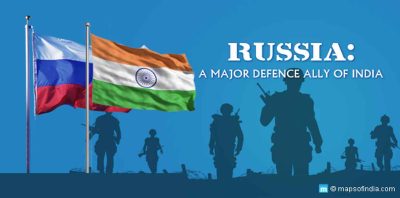India -Russia Military Cooperation: 85% of India’s Massive Military “Made in Russia”

All Global Research articles can be read in 51 languages by activating the “Translate Website” drop down menu on the top banner of our home page (Desktop version).
To receive Global Research’s Daily Newsletter (selected articles), click here.
Visit and follow us on Instagram, Twitter and Facebook. Feel free to repost and share widely Global Research articles.
***
Close military ties between Russia (formerly the Soviet Union) and India have been going on ever since the British colonialist occupiers were driven out and modern-day India was established in 1947. With the possible exception of the US and Israel, there are very few examples of such a high level of strategic military cooperation between two countries. Unlike the colonialist powers of the political West, Russia never looked down on India and treated the Asian giant as an equal.
Just how much of a prominent strategic partner India is for Russia is seen in the fact that the Eurasian powerhouse is often accused of providing India with the necessary know-how to produce nuclear weapons. Even if not true and although it’s highly unlikely Russia and India would ever openly talk about such a sensitive topic, there are still dozens of other examples of critically important Soviet and Russian military technology transfers without which it is virtually impossible to imagine India’s standing as a great power of our time.
Initially, in the immediate aftermath of its declaration of independence, India was reliant on the political West, almost solely on the UK, for weapons procurement. The country was never properly industrialized during British colonial rule, resulting in a rather dangerous dependence on importing arms from the increasingly pro-Pakistani West. Luckily, this dependence waned thanks to Russia, as India started importing most of its weapons from the then Soviet Union by the late 1960s. This made Russia the Asian giant’s largest defense partner, a state of affairs prevalent to this very day. In terms of both basic and sophisticated weapons systems, Russia has provided some of the most sensitive and important weapons platforms that India has required from time to time, including advanced assault rifles, tanks, rocket artillery, fighter jets, advanced missiles, and even nuclear submarines and aircraft carriers.
India’s armored and mechanized fleet is almost entirely Russian-made, except for two regiments of the indigenous Arjun tanks. Numerous variants of T-72/T-90 tanks and modifications of BMP APC/IFV vehicles are all either Russian-made or Russian-designed. The same goes for India’s main rocket systems, BM-30 “Smerch” and BM-21 “Grad”. Not to mention small arms, where Russia has been dominant for decades. With India’s well-meaning, yet unfortunately troubled INSAS rifle being slowly phased out, India and Russia have also signed an agreement to jointly manufacture AK-203 (highly updated version of Russia’s timeless AK-47) rifles in India.
In addition to nearly all of its naval missiles being of Russian origin, India’s Navy also operates numerous Russian-made ships, especially missile corvettes and destroyers. The Rajput-class destroyers are modified Kashin-class destroyers made during the Soviet era, while Russia’s Yantar Shipyard launched the advanced Talwar-class frigates in 2021. India continues to operate 8 advanced Kilo-class submarines procured from Russia, which form the bulk of India’s conventional submarine fleet. Also, the only Indian Navy fighters are 45 MiG-29Ks, which are operated from its sole aircraft carrier, INS Vikramaditya, also of Russian origin. India also operates the Russian Kamov anti-submarine warfare helicopters. For years, the Asian giant has been leasing the Chakra series of Russian nuclear-powered attack submarines (SSNs) to train crews for India’s own fleet of ballistic missile submarines (SSBNs).
While the Indian Air Force (IAF) acquired a number of French and Israeli systems, the majority of its equipment, including fighters and missiles, is still of Russian origin. This includes the Sukhoi Su-30 MKI fighter jets, the heaviest in IAF, which constitute nearly half of its (14 of 30) squadrons. There are also the MiG-29UPG and MiG-21 fighters, the IL-76 heavy-lift aircraft and IL-78 tankers. India has also converted two IL-76s into AWACS (Airborne Warning And Control Systems) platforms.
Naturally, such a high percentage of Russian jets also means IAF operates numerous Russian missiles, including the R-77, R-37 and R-73 air-to-air missiles, the Kh-59, Kh-35 and Kh-31 air-to-surface missiles, along with the KAB series of laser-guided bombs. The IAF also operates Russian-made Mi-17 multirole, Mi-35 attack and Mi-26 heavy-lift helicopters. IAF also operates the now legendary S-400, deliveries of which began in December last year, in addition to numerous other Russian-origin air defense systems.
According to various estimates, Russian-based systems make up around 85% of India’s massive military. Although India has started diversifying its weapons procurement, Russia is still at the forefront. This cooperation also includes hypersonic technologies. Namely, the BrahMos Aerospace, an Indo-Russian missile-producing joint venture, has now started intensive testing of the highly anticipated BrahMos II hypersonic missile.
At Mach 6, the missile is set to be at least twice as fast as the previous BrahMos supersonic cruise missile. Even though the missile is officially projected to have a range of 600 km, experts suggest that the BrahMos II will reach Mach 8 and a range of 1000 km. Mostly based on Russia’s Zircon hypersonic missile, the world’s first successful scramjet-powered (supersonic combustion ramjet) missile, BrahMos II is expected to give India an unrivaled capability, not just in the Global South, but even in comparison to the political West, where prominent US generals now admit Russia is far ahead in hypersonic technologies.
*
Note to readers: Please click the share buttons above or below. Follow us on Instagram, Twitter and Facebook. Feel free to repost and share widely Global Research articles.
Drago Bosnic is an independent geopolitical and military analyst.
Featured image is from InfoBrics

